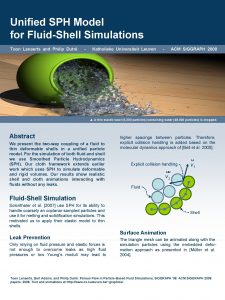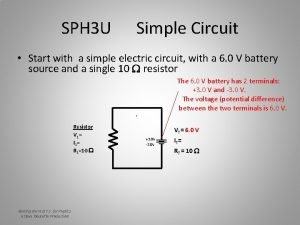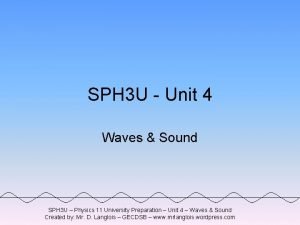SPH 3 U Simple Circuit Start with a









- Slides: 9

SPH 3 U Simple Circuit • Start with a simple electric circuit, with a 6. 0 V battery source and a single 10 W resistor The 6. 0 V battery has 2 terminals: +3. 0 V and -3. 0 V. The voltage (potential difference) between the two terminals is 6. 0 V. Resistor V 1= I 1= R 1=10 W Getting the H. O. T. S. for Physics a Dave Doucette Production VT= 6. 0 V +3. 0 V -3. 0 V IT = RT = 10 W

SPH 3 U Simple Circuit • Start with a simple electric circuit, with a 6. 0 V battery source and a single 10 W resistor This conducting wire has a voltage of +3. 0 V The 6. 0 V battery has 2 terminals: +3. 0 V and -3. 0 V +3. 0 V Resistor V 1= I 1= R 1=10 W +3. 0 V VT= 6. 0 V -3. 0 V RT = 10 W -3. 0 V Getting the H. O. T. S. for Physics a Dave Doucette Production IT = +3. 0 V -3. 0 V This conducting wire has a voltage of -3. 0 V

SPH 3 U Simple Circuit • Start with a simple electric circuit, with a 6. 0 V battery source and a single 10 W resistor This conducting wire has a voltage of +3. 0 V The 6. 0 V battery has 2 terminals: +3. 0 V and -3. 0 V +3. 0 V Resistor V 1= I 1= R 1=10 W +3. 0 V VT= 6. 0 VV -3. 0 V RT = 10 W -3. 0 V Getting the H. O. T. S. for Physics a Dave Doucette Production 0. 60 AA IT= 6. 0 V/10 W = 0. 60 +3. 0 V -3. 0 V This conducting wire has a voltage of -3. 0 V

SPH 3 U Series Circuit • Now we add a second 10 W resistor in series This conducting wire is midway between +3. 0 V and -3. 0 V, ie, 0. 0 V Resistor 2 V 1= 3. 0 V I 1= R 1=10 W This conducting wire has a voltage of +3. 0 V Resistor 1 V 1= 3. 0 V I 1= R 1=10 W VT= 6. 0 V -3. 0 V RT = 20 W -3. 0 V Getting the H. O. T. S. for Physics a Dave Doucette Production 0. 30 AA IT= 6. 0 V/20 W = 0. 30 +3. 0 V -3. 0 V This conducting wire still has a voltage of -3. 0 V

SPH 3 U Series Circuit • Let us look at this circuit again – in terms of the potential differences across the source and the resistors The voltage across resistor 1 is 3. 0 V 0. 0 V +3. 0 V + = +3. 0 V The voltage across resistor 2 is 3. 0 V The voltage across the source is 6. 0 V +3. 0 V -3. 0 V The sum of the potential differences across the resistors equals the potential difference across the source. This occurs due to the distribution of surface charge. Getting the H. O. T. S. for Physics a Dave Doucette Production

SPH 3 U Series Circuit • Now we add a third 10 W resistor in series This conducting wire has a voltage of +1. 0 V Resistor 2 V 1= 2. 0 V I 1= R 1=10 W This conducting wire Still has a voltage of +3. 0 V Resistor 1 V 1= 2. 0 V I 1= R 1=10 W VT= 6. 0 V IT= 6. 0 V/30 W = 0. 20 AA +3. 0 V -3. 0 V RT = 30 W -3. 0 V This conducting wire has a voltage of -1. 0 V Getting the H. O. T. S. for Physics a Dave Doucette Production -1. 0 V -3. 0 V Resistor 3 V 1= 2. 0 V I 1= R 1=10 W This conducting wire still has a voltage of -3. 0 V

SPH 3 U Series Circuit • Let us look at this circuit again – in terms of the potential differences across the source and the resistors The voltage across resistor 1 is 2. 0 V +1. 0 V +3. 0 V + = +3. 0 V The voltage across resistor 2 is 2. 0 V The voltage across the source is 6. 0 V +3. 0 V -3. 0 V -1. 0 V -3. 0 V The voltage across resistor 3 is 2. 0 VV Getting the H. O. T. S. for Physics a Dave Doucette Production +

Part 2 Potential Difference & Parallel Circuits

SPH 3 U Parallel Circuit • Start with a 12 V battery source and two 8. 0 W resistors, in a parallel circuit: These conducting wires have a voltage of +6. 0 V Resistor 1 V 1= I 1= 1. 5 A R 1=8. 0 W Resistor 2 V 2= I 2= 1. 5 A R 2=8. 0 W +6. 0 V The 12 V battery has 2 terminals: +6. 0 V and -6. 0 V. The voltage (potential difference) between the two terminals is 12 V. VT= 12 12 VV +6. 0 V -6. 0 V IT= 12 V / 4. 0 W = 3. 0 A RT = _______1_____ = 4. 0 W 1/8. 0 + 1/8. 0 -6. 0 V These conducting wires have a voltage of +6. 0 V Getting the H. O. T. S. for Physics a Dave Doucette Production

















